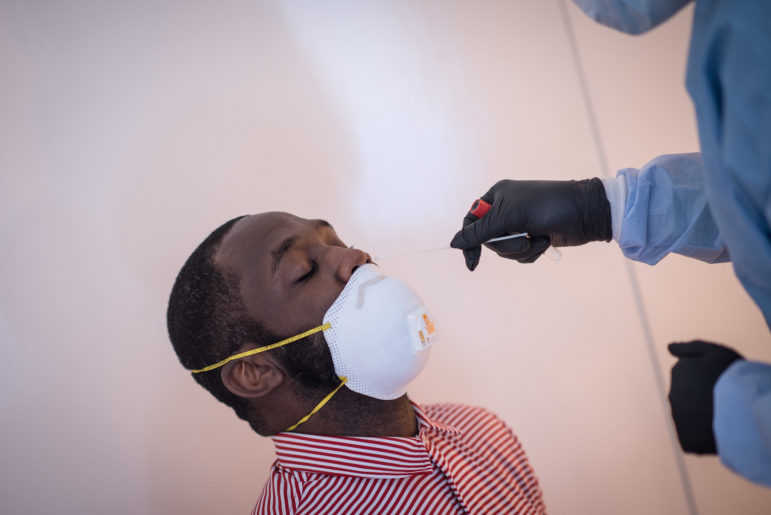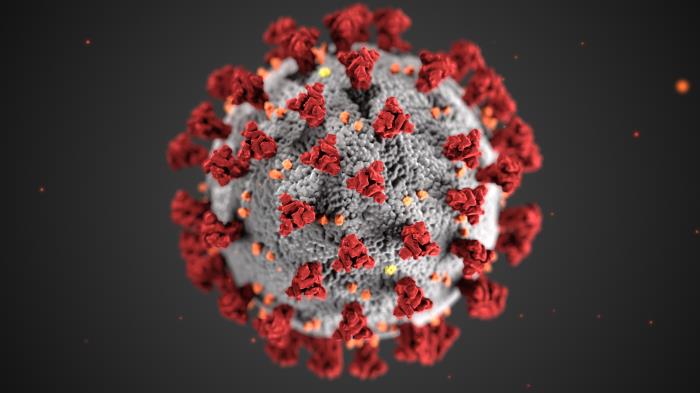Those who’ve tried to use the service in recent weeks say there haven’t been enough hotel rooms to meet demand. They report delays in obtaining a room, sometimes three days or more, even as the CDC recently cut its recommended isolation time down to five days.

Michael Appleton/Mayoral Photography Office
A resident receives a COVID-19 test at a city site in Manhattan in 2020.
When Sam Bellamy tested positive for COVID on Dec. 16, he immediately called the city’s hotline for a free hotel room. He lives in Brooklyn with two roommates, one of whom was unable to get the booster due to health concerns, so he knew isolating at home would be tricky.

New York City’s
Coronavirus crisis.
Bellamy waited on hold for an hour and a half to register, only to realize he would need more time to gather his work effects before being picked up by the free transport service the city offers as part of its COVID-19 Isolation Hotel Program. So he asked to be picked up the next day. But when he called back that Friday night, he was told he hadn’t even been put in the system. So he had to get registered anew and begin the wait again.
He started doing sponge baths in his shared bathroom instead of showering without a mask, expecting to be into a hotel room soon enough. A friend of his who used the program in November told him she’d been picked up in mere hours. He called the hotline daily, waiting on hold for up to two hours each time.
But it wasn’t until the night of Dec. 19—three days after his diagnosis and his initial attempt to secure an isolation space—that Sam was given a room in the LaGuardia Plaza Hotel in Queens.
“First thing I did when I got here was take a shower!” he said.
As the omicron variant overwhelms New York City, residents with roommates and family they need to isolate from are calling the city’s free hotel room program, called Take Care, for a safe place to recuperate. Launched at the start of the pandemic, the service provides participants with three meals a day, round-trip transportation, medication delivery and more—all free of charge.
But as local politicians and media have continued touting the program’s benefits, spiking COVID-19 cases appear to be straining its efficiency. Those who’ve tried to use the service in recent weeks (including this reporter) say there haven’t been enough hotel rooms to meet the demand. Residents are reporting long delays in obtaining an isolation room, of three days or more, even as the CDC recently cut its recommended isolation time down to five days.
The delays are particularly concerning for people who are already unhoused. COVID cases are once again rapidly spreading through the city’s shelter system, where residents are often housed in congregate, dorm-style rooms with multiple people.
A worker at a nonprofit that employs some unhoused people told City Limits they called the hotel hotline to try and secure a room for an employee who could no longer stay in a homeless shelter due to a COVID exposure. They waited on hold for four hours last Wednesday, Dec. 22, and for six hours the next day, they said—and still were unable to get through to a real person.
NYC Health + Hospitals declined to answer questions about how many isolation hotel rooms are currently contracted for the program, or what average wait times are for the rooms, but acknowledged the capacity issues fueled by increasing omicron cases.
“Our Take Care hotel program has seen a rise in numbers, as was to be expected around the holidays and with the colder weather bringing people indoors. Like many other industries, staffing challenges have impacted our operations,” a representative told City Limits in a statement. “We are working to add more hotel rooms by the first week of January to accommodate visitors and residents of New York, especially those with roommates and multi-generational families, who may otherwise not have a safe, comfortable place to quarantine or isolate.”
Rumors of the long wait times for the hotel rooms are dissuading some New Yorkers from even calling. Cissy Yu, 26, took advantage of the program in November when she tested positive for COVID. She unfortunately contracted the virus again on Dec. 21. She decided that this time, she’d try to stay home, but was still concerned about exposing her housemates.
“I kind of assumed the hotel would be really backed up because so many people have COVID right now,” she said, adding that she read about the days-long waits on a Reddit thread. “Last time I was there, a nurse mentioned when they get a surge of patients they’re not staffed very well to handle huge loads.”
The omicron variant has caused such a surge. The CDC estimated that over 90 percent of COVID cases in the tri-state area are caused by the new variant. Prior to this latest spike, the hotel room system appeared to be working smoothly. When Christopher Nickelson, 27, called the hotel hotline in mid-November, he remembers being on hold for about five minutes and was able to schedule a pickup for the same day.
“The program was really such a lifesaver,” he said. Nickelson said he was experiencing multiple COVID symptoms and was so sapped of energy that he knew he couldn’t cook for himself every day. The LaGuardia Plaza Hotel, where he was placed, provided three meals a day, and he had regular check-ins with a nurse.
Nickelson said a nurse told him that during his stay, the hotel was around half capacity. At that time, NYC’s seven-day case average was about 1,400. The Queens hotel near the airport has 358 rooms, according to its website. As of Dec. 27, the city’s seven-day COVID case rate was over 20,000, having doubled in less than a week.
It’s not clear if LaGuardia Plaza is the only hotel the city is using for its isolation program; Health + Hospital officials did not respond to City Limits’ inquiries about how many sites it is currently contracting with. The Department of Homeless Services (DHS) has also leased rooms at at least four hotels specifically for homeless shelter residents who’ve been exposed to or tested positive for COVID, officials said last week.
The city appears to be working to expand the Take Care program to new hotels. James Fitzgerald, 27, was given a room in the Holiday Inn at LaGuardia Airport on Dec.16 after testing positive. He said a staffer told him that this hotel was slated to open later in the year, but the city expedited the process to open it that week. (The Holiday Inn did not respond to a request for comment, but its website says the hotel has 217 rooms.)
This reporter is one of the many New Yorkers who faced this issue. I received my positive COVID result after waiting in line for a rapid test for over three hours on Sunday, Dec.19—so I called the city’s hotel program hotline. After a two-hour hold, I was placed in the queue and told I should hear about a room in 24 hours.
But that time came and went, and on subsequent daily calls, I was told that they were unable to give me an estimate and they were backed up. Nine days later, I’m still at home.
Have you had an experience with the city’s COVID-19 Isolation Hotel Program? Tell us about it by emailing editor@citylimits.org
The post Long Waits for NYC’s COVID-19 Isolation Hotel Rooms, As Omicron Cases Spike appeared first on City Limits.



 & © 2021 Cable News Network, Inc., a WarnerMedia Company. All rights reserved.
& © 2021 Cable News Network, Inc., a WarnerMedia Company. All rights reserved.






